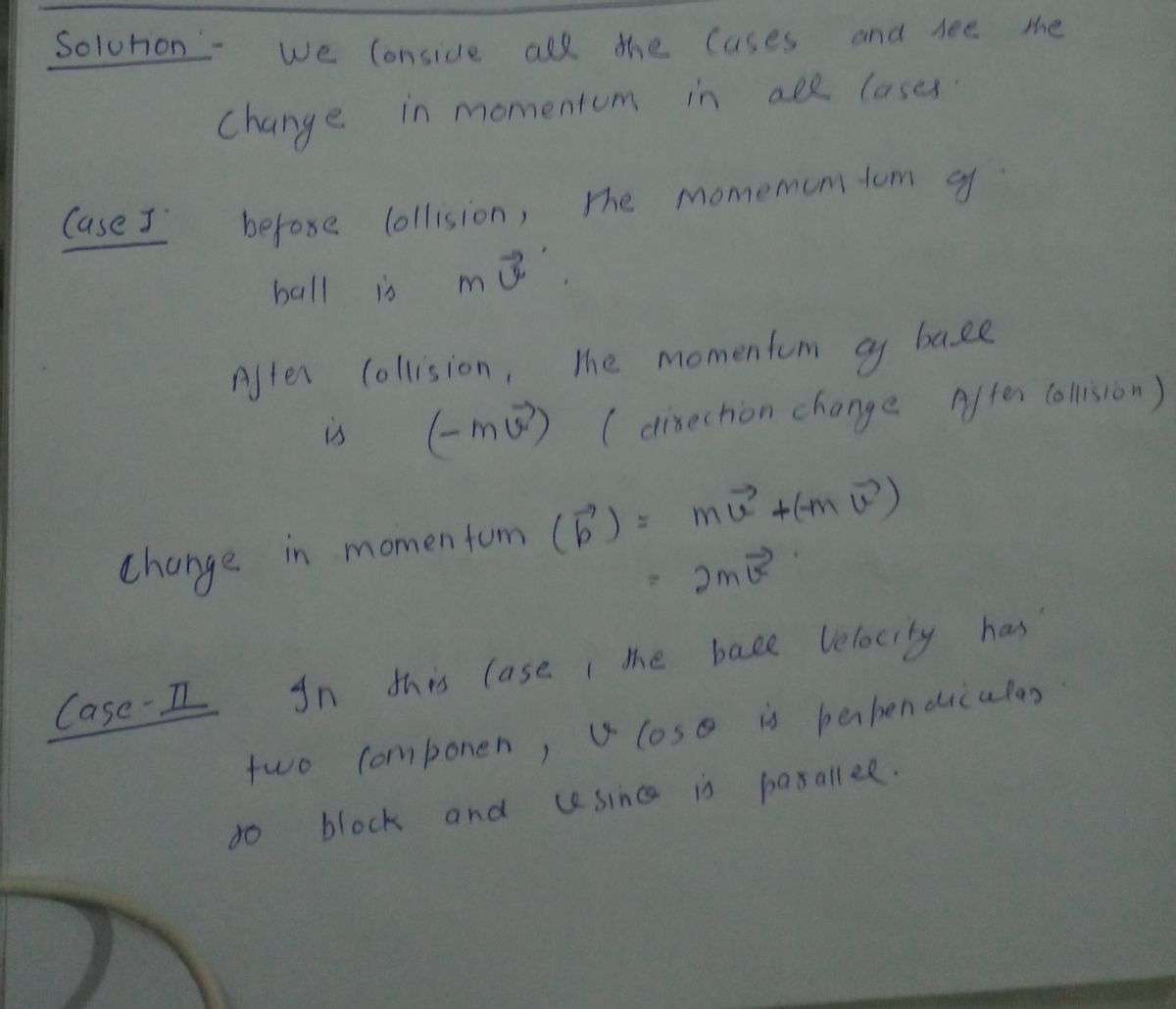In collision A, the ball hit the block of wood and bounced back to the left with the same speed. The initial and final velocities were both perpendicular to the surface of the block. In collision B, the ball hit the block with a velocity that was not perpendicular to the surface of the block. The ball bounced back to the left with a velocity that made the same angle with the surface of the block. The initial and final speeds of the ball were the same as in collision A. In collision C, the ball hit the block and lost all of its speed, thus dropping to the base of the block of wood (and remaining there at rest). In collision D, the ball knocked the block down and the ball continued to the right at a reduced speed. Again, the initial speed of the ball was the same in each collision. In which collision, A through D, was the magnitude of the change in momentum of the ball the greatest? D It is impossible to know without more information.
In collision A, the ball hit the block of wood and bounced back to the left with the same speed. The initial and final velocities were both perpendicular to the surface of the block. In collision B, the ball hit the block with a velocity that was not perpendicular to the surface of the block. The ball bounced back to the left with a velocity that made the same angle with the surface of the block. The initial and final speeds of the ball were the same as in collision A. In collision C, the ball hit the block and lost all of its speed, thus dropping to the base of the block of wood (and remaining there at rest). In collision D, the ball knocked the block down and the ball continued to the right at a reduced speed. Again, the initial speed of the ball was the same in each collision. In which collision, A through D, was the magnitude of the change in momentum of the ball the greatest? D It is impossible to know without more information.
College Physics
11th Edition
ISBN:9781305952300
Author:Raymond A. Serway, Chris Vuille
Publisher:Raymond A. Serway, Chris Vuille
Chapter1: Units, Trigonometry. And Vectors
Section: Chapter Questions
Problem 1CQ: Estimate the order of magnitude of the length, in meters, of each of the following; (a) a mouse, (b)...
Related questions
Question

Transcribed Image Text:The figure below shows four diagrams (labeled A through D) of a collision between a ball (shown in black) and a block of wood (shown in tan). Each diagram shows the situation before and after the collision.
In each collision the same ball approaches the block of wood from the left. The initial speed of the ball (the speed of the ball before the collision) was the same in each collision. Assume air resistance and other sources of friction are negligible in all cases. The collision
happens quickly enough that the effect of gravity on the ball can be ignored as well.
Before
After
A
(same speed)
В
Before
After
(same speed)
Before
After
(stopped)
Before
After
(slower)
In collision A, the ball hit the block of wood and bounced back to the left with the same speed. The initial and final velocities were both perpendicular to the surface of the block.
In collision B, the ball hit the block with a velocity that was not perpendicular to the surface of the block. The ball bounced back to the left with a velocity that made the same angle with the surface of the block. The initial and final speeds of the ball were the same as in
collision A.
In collision C, the ball hit the block and lost all of its speed, thus dropping to the base of the block of wood (and remaining there at rest).
In collision D, the ball knocked the block down and the ball continued to the right at a reduced speed.
Again, the initial speed of the ball was the same in each collision.
In which collision, A through D, was the magnitude of the change in momentum of the ball the greatest?
C
O D
O A
It is impossible to know without more information.
В
Expert Solution
Step 1

Trending now
This is a popular solution!
Step by step
Solved in 2 steps with 2 images

Knowledge Booster
Learn more about
Need a deep-dive on the concept behind this application? Look no further. Learn more about this topic, physics and related others by exploring similar questions and additional content below.Recommended textbooks for you

College Physics
Physics
ISBN:
9781305952300
Author:
Raymond A. Serway, Chris Vuille
Publisher:
Cengage Learning

University Physics (14th Edition)
Physics
ISBN:
9780133969290
Author:
Hugh D. Young, Roger A. Freedman
Publisher:
PEARSON

Introduction To Quantum Mechanics
Physics
ISBN:
9781107189638
Author:
Griffiths, David J., Schroeter, Darrell F.
Publisher:
Cambridge University Press

College Physics
Physics
ISBN:
9781305952300
Author:
Raymond A. Serway, Chris Vuille
Publisher:
Cengage Learning

University Physics (14th Edition)
Physics
ISBN:
9780133969290
Author:
Hugh D. Young, Roger A. Freedman
Publisher:
PEARSON

Introduction To Quantum Mechanics
Physics
ISBN:
9781107189638
Author:
Griffiths, David J., Schroeter, Darrell F.
Publisher:
Cambridge University Press

Physics for Scientists and Engineers
Physics
ISBN:
9781337553278
Author:
Raymond A. Serway, John W. Jewett
Publisher:
Cengage Learning

Lecture- Tutorials for Introductory Astronomy
Physics
ISBN:
9780321820464
Author:
Edward E. Prather, Tim P. Slater, Jeff P. Adams, Gina Brissenden
Publisher:
Addison-Wesley

College Physics: A Strategic Approach (4th Editio…
Physics
ISBN:
9780134609034
Author:
Randall D. Knight (Professor Emeritus), Brian Jones, Stuart Field
Publisher:
PEARSON